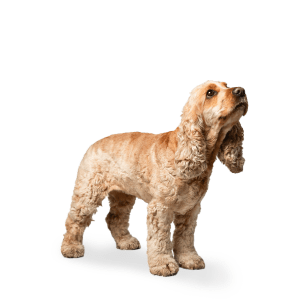

Diarrhoea in dogs: What do I need to know?
It happens to every dog at some point – and let’s be honest, most owners too. Diarrhoea simply means poo that’s softer than usual. That could be anything from soft-serve consistency to an unformed mound, porridge-like texture or even completely liquid.
If it’s a one-off and your dog seems bright and active, most owners – and even most vets – won’t be too concerned. But if it happens twice, or you spot other signs, it’s worth paying closer attention.
Need a reference? We’ve put together a handy dog poo chart to help you figure out what’s normal – and what’s not.
What are the causes of diarrhoea in dogs?
The list of potential causes is longer than a giraffe’s neck – but here are some of the most common reasons why your dog might have diarrhoea:
- Dietary change or dog food allergies – Sudden changes, new treats or scraps from the table can upset their stomach
- Dietary indiscretion – If your dog has eaten something they shouldn’t – whether it’s fresh or foul – it can lead to trouble
- Toxins – Including things like chocolate, grapes or cleaning products
- Foreign bodies – From bones to toys to bits of fabric
- Parasites – Not just worms, but also microscopic ones like Giardia
- Infections – Bacterial, viral or fungal
- Organ dysfunction or inflammation – Including issues with the liver, kidneys or pancreas
- Medications – Some treatments can irritate the gut
- Stress or overheating – Both can impact digestion and gut movement, so it's important to recognise the signs of stress in dogs.
Even if the cause seems minor, it’s worth keeping a close eye. Without proper care, mild diarrhoea can lead to more serious concerns like vomiting and diarrhoea (also called gastroenteritis), or in more severe cases, bloody diarrhoea and haemorrhagic gastroenteritis (HGE).
Types of diarrhoea in dogs
Diarrhoea in dogs usually falls into one of two types. Knowing the difference can help you describe what’s going on more clearly when speaking to your vet.
Small intestinal diarrhoea
This starts higher up in the digestive tract. Dogs with this type can often wait until they’re outside – then pass a large amount of loose stool in one go. There’s usually less straining, and you’re less likely to see mucus or visible blood.
Large intestinal diarrhoea
This comes from lower down in the gut. The urge to go can be sudden and frequent, which may lead to accidents in the house. You might notice your dog straining, passing small piles – or puddles – of poo, often with fresh red blood or mucus.

What are the treatments for diarrhoea in dogs?
If your dog is otherwise fit and healthy, one of the simplest ways to manage diarrhoea is a short break from food. A 12-24 hour fast gives the gut time to clear out anything irritating it before more food is introduced.
But don’t go too long – the gut relies on nutrients from food to heal and work properly. Extended fasting can actually slow down recovery. (We’ll cover what to feed a little further down.)
If your dog needs veterinary care, treatment may begin with tests to look for an underlying cause. In some cases, vets will focus on supportive care – things like fluids, prescription diets, gut protectants, absorbents or binding agents, and possibly worming treatments or antibiotics.
What to give a dog with diarrhoea
Because diarrhoea is so common, there are some excellent pet-specific products designed to help you manage it at home. One widely used option is a probiotic binding paste. It helps by soaking up excess water in the gut and supporting a healthy balance of good bacteria – giving your dog’s digestion a helping hand while things settle. Learn more about how to support your dog's digestion.
What to feed a dog with diarrhoea
A bland diet is often recommended for dogs with diarrhoea – and with good reason. When the gut is inflamed and moving too quickly, it can struggle to process normal food or full-sized meals.
-
Low-fat options
A common go-to is boiled, skinless chicken mixed with cooked white rice. If your dog is allergic to chicken, boiled egg can work well too. You can also find vet-recommended tinned foods that offer easy-to-digest nutrition – without the need for cooking. -
Small portions
After a 12-24 hour fast, start slow. Offer just a teaspoon for small dogs, or a serving spoon for larger breeds. -
Little and often
Feed small amounts every 2-4 hours. This helps avoid overwhelming the gut while it recovers. -
Gradual return to normal
Stick to the bland diet for 3-5 days, gradually increasing portion size if things start to settle. Once your dog’s poos are back to normal, you can slowly transition them back to their regular food.
What to do about bloody diarrhoea in dogs
It’s not unusual to spot a small amount of blood in your dog’s diarrhoea. Light bleeding can happen from straining, often showing up as a few streaks or drops on the surface after they’ve finished going.
But if you notice blood mixed into the diarrhoea itself, it’s a sign of something more serious. This often points to inflammation in the gut – which in some cases can allow bacteria to pass into the bloodstream.
If that’s the case, it’s best to get your dog checked by a vet. They’ll examine the cause and may recommend treatment such as antibiotics – though not all cases need them.

Puppy diarrhoea
Puppies go through a lot of changes that can trigger diarrhoea – from weaning and diet transitions to worming treatments, settling into a new home or starting walks. They’re also naturally curious, which means they’re more likely to chew or swallow things they shouldn’t.
While serious causes like parvovirus are always a concern, even mild diarrhoea can escalate quickly in puppies. They can become dehydrated much faster than adult dogs, and it’s not usually recommended to withhold food – especially for very young or toy breeds. Read our guide on how often your puppy should poop.
If your puppy still seems bright, playful and curious, you can offer tiny portions of bland food. But if the diarrhoea lasts more than 12-24 hours – or you notice other worrying signs – it’s best to contact your vet.
Diarrhoea in old dogs
Older dogs can be more prone to mild upsets, and sometimes diarrhoea is linked to an underlying health issue. Medication can also play a part. For example, NSAIDs (non-steroidal anti-inflammatory drugs) – often used to support joint health – can occasionally cause or worsen diarrhoea.
If your senior dog has an existing condition or takes regular medication, it’s a good idea to call your vet at the first sign of diarrhoea. They’ll be able to guide you on the best next steps and help avoid any complications.
How to prevent diarrhoea in dogs
While some causes of diarrhoea are outside your control, there are simple steps you can take to support healthy digestion in dogs and help reduce the risk of tummy upsets:
- Make any diet changes gradually – ideally over 5-7 days
- Store food properly to keep it fresh – and out of reach
- Keep food and water bowls clean, and always offer fresh water
- Puppy-proof your home – secure bins, store medicines safely and choose non-toxic plants and cleaning products
- Stay on top of routine care like vaccinations and worming
Small daily habits can go a long way in helping your dog maintain a happy, healthy gut.
When to consult your vet
Diarrhoea in dogs is very common – and in many cases, it clears up without a trip to the vet. But there are times when it’s best to get professional advice:
- Two or more episodes that are getting softer or more watery
- Blood mixed into the diarrhoea – especially if it looks like raspberry jam
- Diarrhoea with signs like lethargy, a bloated or tense tummy, or signs of pain
- If your dog is very young, very old or has existing health conditions
- Loose stools that continue or worsen despite fasting or a bland diet
If you’re unsure, it’s always okay to call your vet. A quick chat could offer peace of mind – or help catch something more serious early.
At the clinic, your vet will usually check for signs of dehydration, tummy tenderness or a raised temperature. From there, they’ll guide you on the best course of action – whether it’s at-home care or further tests and treatment.



